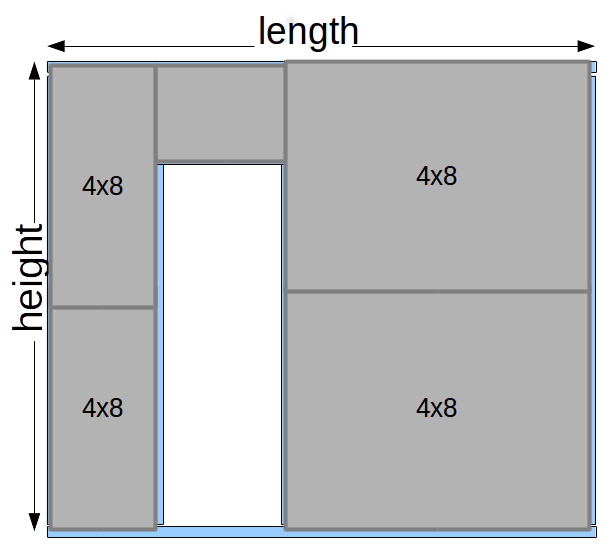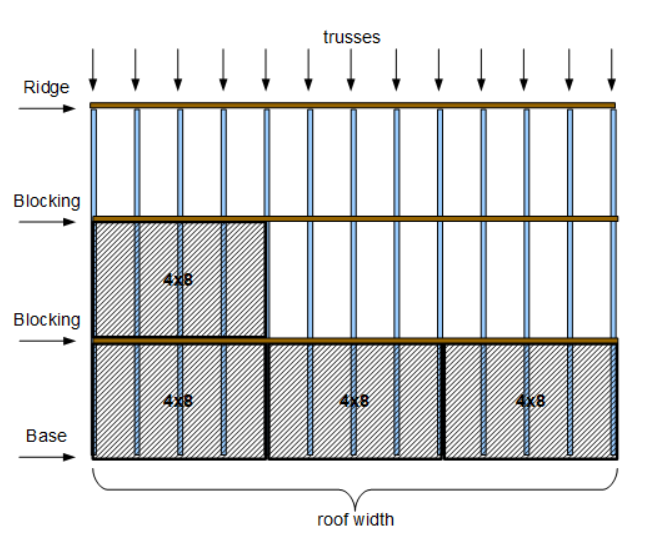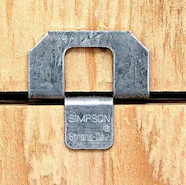Sheathing for a Wall
The Number of Plywood or OSB Sheets Needed for a Wall calculator computes the number of 4x8 sheets required to cover a wall based on the length and height of the wall.
computes the number of 4x8 sheets required to cover a wall based on the length and height of the wall.
INSTRUCTIONS: Choose units and enter the following:
- (L) Length of Wall
- (H) Height of Wall
4x8 Sheets: The calculator returns the number of sheathing boards (4x8's) needed to cover the wall.
4x8 Calculators
- 4x8 Sheathing for Gable Roof:
Computes the total surface area of a roof, the number of 4x8s and framing nails needed for a gabled roof based on the length, span, pitch and overhang.
- 4x8s for Dormers: Computes the number of 4x8 sheathing needed for one or more roof dormers based on the dimensions.
- 4x8 Sheathing for Shed Roof: Computes the total number of 4x8s needed to cover a single sloped roof based on the span, ridge length and the front and back overhangs.
- Sheathing for Hip Roof: Computes the number of 4x8s need to cover the surface area of a hip roof based on the dimensions.
- Sheathing for Gambrel Roof:
Computes the number of 4x8s needed to cover a gambrel roof based on dimensions.
- Pyramid Roof Sheathing: Computes the number of 4x8s needed to cover a pyramid roof.
- House Sheathing: Computes the number of 4x8 sheathing needed for the exterior walls including up into the gables for a house with gable roof based on the dimensions.
- Sheathing for a Wall: Computes the number of 4x8 sheathing to cover a wall.
- Subfloor 4x8 Sheets:
Computes the number of 4x8 subfloor panels to cover a deck or floor joists base don the dimensions.
- Subfloor Cost: Estimates the cost of 4x8 subfloor panels on a deck or floor joists based on dimensions and cost of 4x8s.
- Plywood Cost: Computes the cost to cover an area with 4x8 sheets of plywood or OSB.
- 4x8s for Concrete Wall Forms: Computes the surface area and number of 4x8 sheets for the forms for a concrete wall. It also includes a price estimate based on a unit price of 4x8 sheets.
- 4x8s for Concrete Foundation Forms:
Computes the inner and outer surface area of a rectangular foundation based on the length, width, height and thickness of the poured foundation walls. It then computes the number of 4x8s needed for the forms and the estimated cost of 4x8s based on the unit price per 4x8.
Sheathing refers to the layer of material that's applied to the exterior of a building's frame to provide structural support, insulation, and a surface for attaching exterior finishes such as siding or stucco. Sheathing materials can vary widely depending on factors like climate, building codes, and construction methods. Common types include plywood, oriented strand board (OSB), and various types of composite panels. Sheathing plays a crucial role in strengthening the building structure, providing stability, and protecting against weather elements. Sheathing and subflooring typically come in 4'x8' panels that may be tongue in groove.
Subflooring serves a different purpose compared to sheathing used on walls or roofs. Subflooring provides a sturdy, level surface for the installation of finished flooring materials such as hardwood, laminate, tile, or carpet. The material commonly used for subflooring includes plywood, oriented strand board (OSB), or even traditional tongue-and-groove boards. These materials are installed directly over the floor joists and provide structural support for the flooring above.
Concrete forms, also known as formwork or shuttering, are temporary structures or molds used to contain and shape freshly poured concrete until it sets and becomes self-supporting. They provide the necessary support and shape to the concrete during the curing process. Concrete forms can be custom-built on-site using lumber, plywood, or other materials, or they can be prefabricated and assembled according to specific project requirements. They need to be properly designed and securely anchored to resist the pressure exerted by the wet concrete. Once the concrete has cured and gained sufficient strength, the forms are removed, leaving behind the desired concrete structure.
Plywood and OSB Price Survey Information
The following is web survey of 4x8 sheets of plywood and OSB. It provides the date of the web survey, the store and several price points on items that were advertised on the store's website. This is for convenience only. Local pricing should ALWAYS be used!
- Survey Date: 4/26/24
- Survey Store: Menards
- Price of 4x8 3/4" Plywood: $35.55 USD
- Price of 4x8 5/8" Plywood: $30.78 USD
- Price of 4x8 1/2" Plywood: $28.95 USD
- Price of 4x8 3/8" Plywood: $24.03 USD
- Price of 4x8 3/4" OSB: $30.49 USD
- Price of 4x8 5/8" OSB: $23.87 USD
- Price of 4x8 1/2" OSB: $22.45 USD
- Price of 4x8 1/4" OSB: $18.98 USD
- Price of 4x8 3/4" Pressure Treated Plywood: $50.98 USD
- Price of 4x8 1/2" Pressure Treated Plywood: $44.84 USD
- Price of 4x8 5/8" Grooved Panel Siding: $53.39 USD
- Price of 4x8 1/2" Grooved Panel Siding: $48.99 USD
NOTE 2: Some stores carry plywood and OSB with thicknesses 1/32nd smaller than others. Therefore, 3/4" might be represented by 23/32", 5/8" by 19/32", 1/2" by 15/32", and 3/8" by 11/32".
CAUTION: The pricing information provided is for calculating convenience with NO implied guarantees to the accuracy of the values listed. Authoritative sources should be sought to confirm any value before risking health or wealth on the veracity of the data. Furthermore, Calc gives no guarantee that you will be able to buy products at listed prices or even if they will be available. The data provided is purely a convenience for making estimates, so we strongly recommend that one ALWAYS use local pricing and authoritative specifications.
The Pricing Data can be used for the Subflooring Material Cost Calculator, CLICK HERE or in the Cost of Plywood Calculator,CLICK HERE.
4x8 sheets on Framing
Using the dimensions of the framing to compute the area. Then compute the number of 4x8 sheets required to cover the framing. Modern construction techniques take advantage of the time saving achieved through using pneumatic nail guns. Nail guns are used to rapidly nail sheeting to roof trusses and walls saving time and money.

Blocking or Clips
The number of nails that will be needed are determined by the pattern of nails. There are two different patterns for nails based on whether there is blocking that allows continuous edges or if clips (see picture) are used. The diagram shows the two patterns.


Additional Resources
The following articles provide additional information:
Equations and Data Items
Collections
- Comments
- Attachments
- Stats
No comments |

